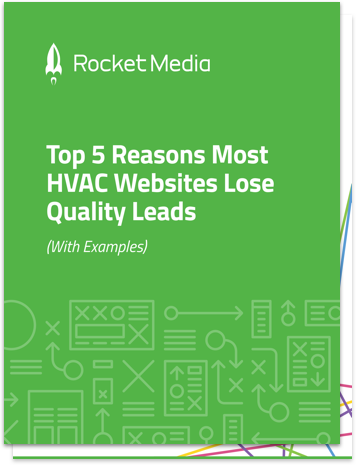HVAC Email Marketing: A Beginner’s Guide
on January 29, 2018
Email marketing can be a great salesperson for your HVAC company. If done right, it can show your customers a little love, while showing your company a little boost in sales.
In this guide, we’ll walk you through how to get started with HVAC email marketing:
1. Choose an email marketing goal.
2. Pick an email marketing platform.
3. Create, segment and built your list.
4. Send relevant content.
5. Respond to emails.
6. Track and test your campaigns.
Let’s dive in.
Step 1: Choose an email marketing goal
When you create your online marketing funnel, you’ll choose a goal for your email marketing. Your goal depends on your customers’ needs and should drive everything you do going forward.
It’s important that you get the right goal, given that when it comes down to it, there are really three reasons HVAC companies use email marketing:
- Stay top-of-mind for old customers
- Upsell non-essential products and services
- Remind customers about tune-ups
We’ll get into campaign ideas later. The next step is choosing how you want to send your emails.
Step 2: Pick an email marketing platform
Webmail providers, like Gmail and Outlook, are great to use personally or within your company. But when it comes to sending bulk emails, you’ll want to use an email marketing platform. These platforms allow you to customize and automate your email campaigns, so you can more effectively market to your customers.
When picking an email marketing platform, consider these factors:
- Size of your contact list
- Number of campaigns
- Cost
- Reputation
If you have less than a couple thousand contacts and only plan on sending a few emails a month, something free like MailChimp would work great for your business.
If you have several thousand contacts and plan on sending more than a few emails a month, you might want something more robust like Emma or even HubSpot, which is a customer relationship management (CRM) system that also does email marketing.
You also want to think about is a platform’s reputation. Like people have credit scores, email senders have reputation scores. Webmail providers (Gmail, Outlook, Yahoo!, etc.) score a sender’s reputation based on spam complaints, spam traps, unknown senders and how your list contacts interact with your emails. The higher your reputation score, the less likely webmail providers will flag your email as spam.
The good news is that most email marketing platforms have good reputations because they make sure users don’t send spam emails.
Look at HubSpot, for example. When you create an email, it lets you know if you’re using any words or tactics that could trigger a send to the spam folder.
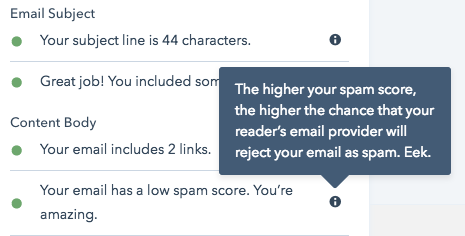
So, how do you get a good sender reputation? Start by building a clean contact list.
Step 3: Create, segment and build your list
The bigger the list the better, right? Not exactly. The more active the list the better.
You want contacts who interact with (open, click through, etc.) your emails. Sending emails to addresses that don’t exist anymore or to ones that don’t interact with your emails can hurt your reputation score, not to mention a campaign’s performance.
As an HVAC company, you’re most likely coming into email marketing with contacts you got from a variety of places (customers, partners, trade shows). So we recommend cleaning up your list to not only make sure your have permission to email contacts, but that they want to get your emails—and to make sure your list stays clean going forward.
Here’s how you can build and maintain a clean list:
- Import your list and clean it up
- Segment your lists
- Make it easy to subscribe
Import your list and clean it up
The best tip we can give for building a clean contacts list is: Permission is key.
To enforce anti-spam laws, most email marketing platforms have strict requirements when importing lists. Following MailChimp’s list requirements and best practices is always a good rule of thumb:
- Get permission. Everyone on your list should have expressed permission to opt in to your communications.
- Include an unsubscribe link in your campaigns. Make it easy for contacts to unsubscribe from your emails. It’s the law.
- Don’t use third-party lists. Don’t rent or buy lists. You should have collected every contact on your list using a proper opt-in method.
Once your contacts are in your email marketing platform, send a re-engagement campaign or a “clean-up” email that makes it easy for your contacts to unsubscribe if they don’t want emails from you. Don’t be offended. You’re better off without someone who could negatively impact your email marketing efforts.
Your clean-up email might look like one ProjStream sent:
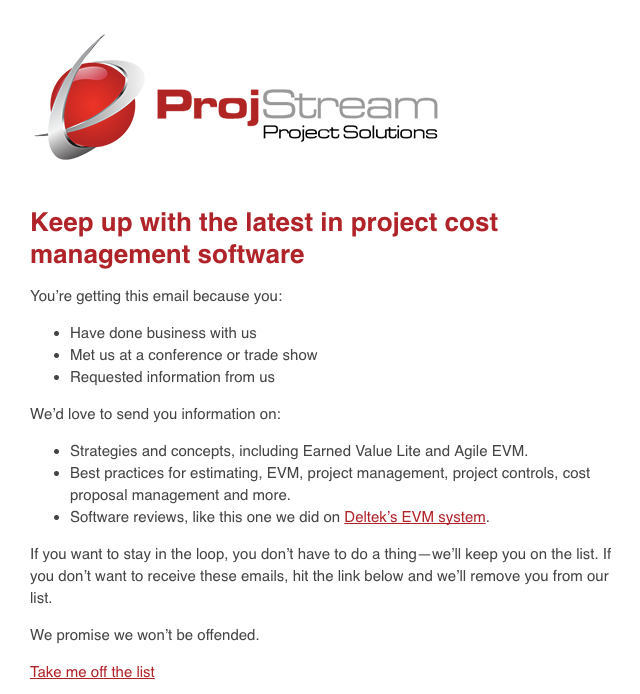
Should you hire a list cleaning service?
We don’t recommend list cleaning services. While they tell you which addresses are less likely to be delivered, they don’t remove them for you—you’re expected to do that yourself.
Using a list cleaning service might solve an immediate problem (invalid email addresses), but they could hide bigger list issues, like spam complaints, spam traps or blacklists. You’d be better off sending a re-engagement or clean-up campaign to get a clean list.
After you clean your list, it’s time to organize it.
Segment your lists
Segmenting your email lists can help your campaigns perform better (think: more opens, higher click-through rates, more sales and so on). You can send different campaigns to different segments, so your contacts get content that’s relevant to them.
Email marketing platforms make it east to segment your contacts by:
- Demographics: Gender, location, job title, etc.
- Behavior: What they buy, how often they buy, when they last opened an email, etc.
- Persona: Customers, partners, contractors, etc.
- New v. old customers
- Membership: Are they part of your maintenance plan or not.
Once you have your list nice and organized, start growing it.
Make it easy to subscribe
To grow your email list, you can:
- Create outstanding content, so people have a reason to subscribe (see next section).
- Entice people to subscribe with offers (discounts, guides, etc.).
- Promote your content through your website, social media, PPC and, of course, email.
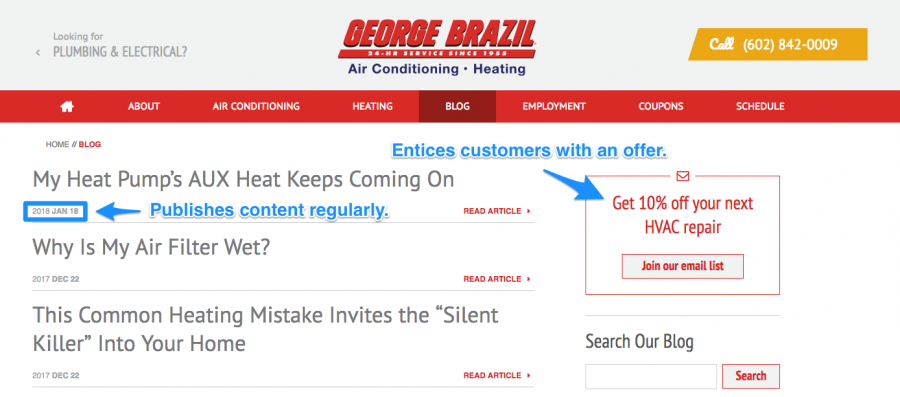
George Brazil does a good job of publishing content on a regular basis and encouraging subscribes with a service discount.
When someone subscribes to your communications, we recommend sending what’s called a “double opt-in” email. This is an email you send to someone after they subscribe, asking them to opt in again. It’s just an extra step to make sure you have permission to email your contacts.
With that in mind, you should never buy an email list. This is like a telemarketer making sales calls to people who don’t know them. Sending emails to someone who never showed interest in your company could hurt your reputation, both online and off.
Now, let’s talk content.
Step 4: Send relevant content
The great thing about email marketing platforms is that it’s easy to give customers content that will interest them.
You can send customers the right content at the right moment by scheduling campaigns to send automatically or triggering a campaign when a contact performs an action (Example: clicks a link, subscribes). This is also known as marketing automation, and it saves you loads of time by eliminating repetitive tasks when creating campaigns.
A lot of our HVAC clients send campaigns like:
- Weekly or monthly newsletters
- Blog posts and other educational content
- Seasonal discounts and offers
- Product comparisons
For example, George Brazil sent their customers this newsletter:
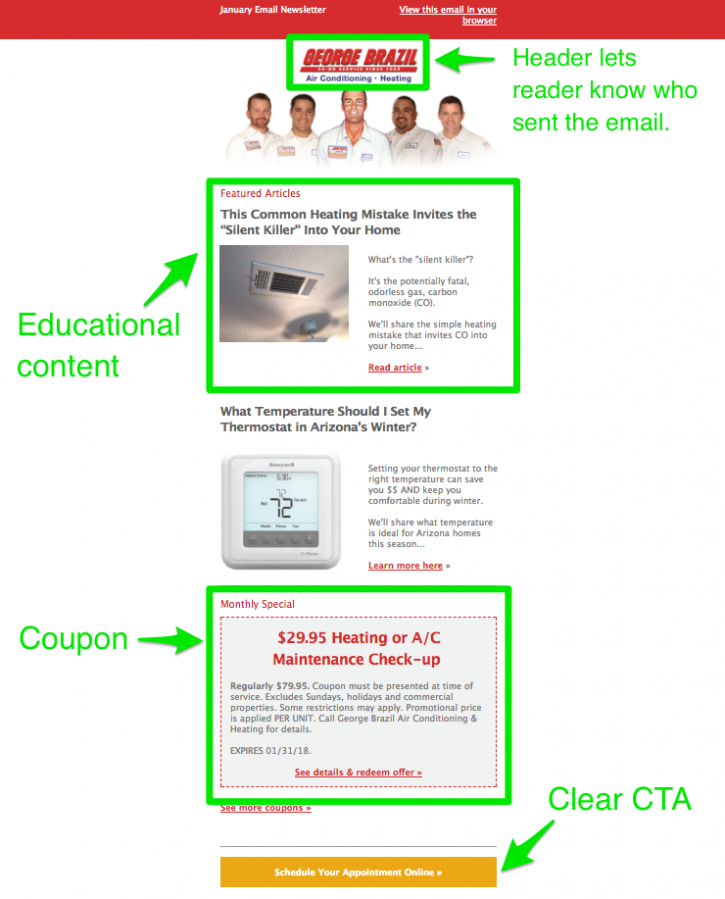
You’ll also want to make sure you deliver emails consistently. Generally, you want to send enough that your customers don’t forget who you are, but not so many that they get overwhelmed and unsubscribe.
For our HVAC clients, we send newsletters monthly and tune-up reminders bi-annually in the Spring and Fall.
Once you start sending emails, don’t forget to set a strategy for responding to them.
Step 5: Respond to emails
You need to make sure your email campaigns are response friendly. People might reply to your monthly newsletter with questions about an offer or a maintenance tip you featured. How frustrated would they be if you never responded?
So, to make sure your emails are response friendly:
- Use an actual email address, something like “hello@” or “info@”. Don’t use a “no-reply@” address. That comes off as impersonal and can deter people from contacting you.
- Respond as soon as you can. If you or your team don’t have time to respond to emails that same day, set up an automated email (almost like an out-of-office) letting people know you’ll get back to them within the next couple days.
- Respond within your email marketing platform, if you can. That way, you’ll have record of every conversation you’ve had with a contact. It could come in handy down the road.
Step 6: Track and test
The glorious thing about email marketing platforms is that you can track your campaigns to see what’s working and what’s not.
In any campaign, you’ll want to keep an eye on:
- Open rate: The percentage of recipients who open your email.
- Click-through rate: The percentage of recipients who clicked on a link in the email.
- Conversion rate: The percentage of recipients who clicked a link and completed a desired action, like purchasing a service or filling out a form.
- Bounce rate: The percentage of emails that couldn’t be delivered to a recipient’s inbox.
If you notice that some of your numbers are low—except for bounce rate, that should be low—try changing up your email content or doing an A/B test.
A/B tests let you send two emails with a variable changed to see which email performs better. Don’t change more than one variable though, otherwise you won’t know which variable impacted the campaign’s performance.
Does your HVAC email marketing need some love?
We’ll give your email marketing the attention it deserves. Give us a call at (800) 339-7305 or contact us today.

